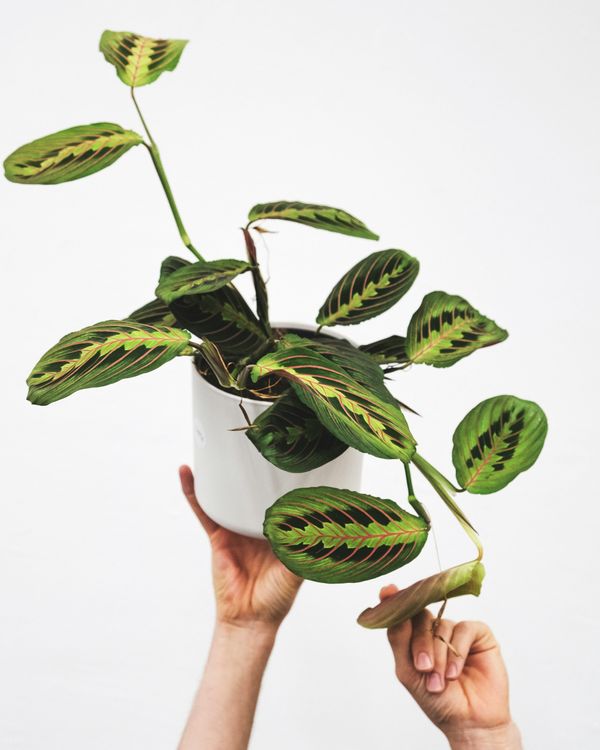Red Prayer Plant Care Guide
How to grow and care for Red Prayer Plant (Maranta leuconeura)
The Maranta leuconeura, commonly known as the Red Prayer Plant, is a popular indoor plant cherished for its stunning foliage and unique habit of raising its leaves upward at night, resembling hands in prayer. This tropical perennial is native to the rainforests of Brazil and thrives in indoor environments with the right care. Its striking red veins and oval-shaped leaves make it a beautiful addition to any home or office space.

Disclosure: This content includes affiliate links, which means we may earn a commission if you click on a link and make a purchase. As an Amazon Associate, we earn from qualifying purchases. This comes at no extra cost to you and helps offset the cost of running Leafwise. Please read our disclaimer for more info.
Table of Contents
Care
Light
Maranta leuconeura, commonly known as the Red Prayer Plant, thrives in bright, indirect light. Direct sunlight can scorch its delicate leaves, while low light may reduce its vibrant coloration. A location near a north or east-facing window is ideal. For optimal vibrancy, provide consistent, filtered light throughout the day.
Watering
Keep the soil evenly moist but not waterlogged. Water when the top inch of soil feels dry to the touch. Use distilled or rainwater to prevent mineral buildup on the leaves, which can cause spotting and discoloration. During winter, reduce watering slightly, allowing the top 1-2 inches to dry before watering again.
Humidity & Temperature
Maintain temperatures between 65°F and 80°F (18°C to 27°C). The Red Prayer Plant thrives in high humidity (above 60%), essential for preventing leaf curling or browning. Use a humidifier, mist the plant daily, or place a tray of water near the plant to maintain moisture in the air, especially during dry seasons.
Soil
Use a well-draining potting mix containing peat moss, perlite, and standard potting soil. This combination helps retain moisture without making the soil too soggy, which can lead to root rot. A slightly acidic pH (5.5 to 6.0) is ideal for optimal growth.
Fertilization
Feed your Maranta every 4-6 weeks during the growing season (spring and summer) using a balanced, water-soluble fertilizer diluted to half strength. In fall and winter, reduce feeding to every 8-10 weeks. Avoid over-fertilizing, as it can cause salt buildup and leaf damage.
Maintenance
Pruning
Prune any yellowing, dead, or damaged leaves regularly to maintain a neat appearance and encourage healthy new growth. Trimming leggy stems can help the plant grow bushier.
Cleaning
Wipe the leaves with a damp cloth to remove dust, which can block light and reduce photosynthesis. Keeping the leaves clean also helps deter pests.
Repotting
Repot every 2-3 years or when the plant becomes root-bound. Choose a pot 1-2 inches larger and refresh the soil to provide new nutrients and room for growth.
Propagation
Maranta leuconeura can be propagated through division or stem cuttings:
Division: During repotting, carefully separate sections of the plant, ensuring each section has its own roots. Replant each division into a new pot with fresh soil.
Stem Cuttings: Take a 3-4 inch cutting with at least one node. You can root the cutting in a clear jar of water to monitor root development or plant it directly into moist soil. If using water propagation, change the water weekly. Keep the cutting in a warm, humid environment until new growth appears.
Common Issues
Pests
Common pests: Maranta plants can attract spider mites, aphids, and mealybugs.
- Prevention: Regularly inspect the plant, maintain high humidity, and keep leaves clean to deter pests, especially spider mites, which thrive in dry conditions.
- Solution: Wipe the leaves with a mixture of water and mild soap or apply neem oil or insecticidal soap weekly until the infestation is resolved.
Root Rot
Cause: Overwatering or poorly draining soil.
- Prevention: Ensure the pot has proper drainage and allow the soil to dry slightly between waterings.
- Solution: If root rot occurs, remove the plant from its pot, trim off any mushy or blackened roots, and repot in fresh, well-draining soil.
Yellowing Leaves
Cause: Overwatering, low humidity, or insufficient light.
- Solution: Check the soil moisture and reduce watering if necessary. Increase humidity by misting or using a humidifier. Move the plant to a location with brighter indirect light.
Brown Leaf Tips or Edges
Cause: Low humidity, exposure to tap water, or inconsistent watering.
- Solution: Increase humidity and use distilled or rainwater to avoid mineral buildup. Maintain consistent watering to prevent stress.
Leaf Spot Diseases
Cause: Prolonged moisture on the leaves or poor air circulation.
- Solution: Water at the base of the plant to keep the foliage dry and improve air circulation by spacing plants apart. If leaf spot occurs, trim affected leaves and apply a fungicide if necessary.
By following these care instructions, your Red Prayer Plant will reward you with vibrant foliage and dynamic movements that bring life to your indoor space.
